How to build your podcast audience
Looking to attract more listeners to your podcast? Build your podcast subscriber base? Reach a wider audience with your auditory content? In this article we’ll share some of the most effective methods to promote, market, and advertise your podcast to build your listenership.
Why should you build your podcast listenership?
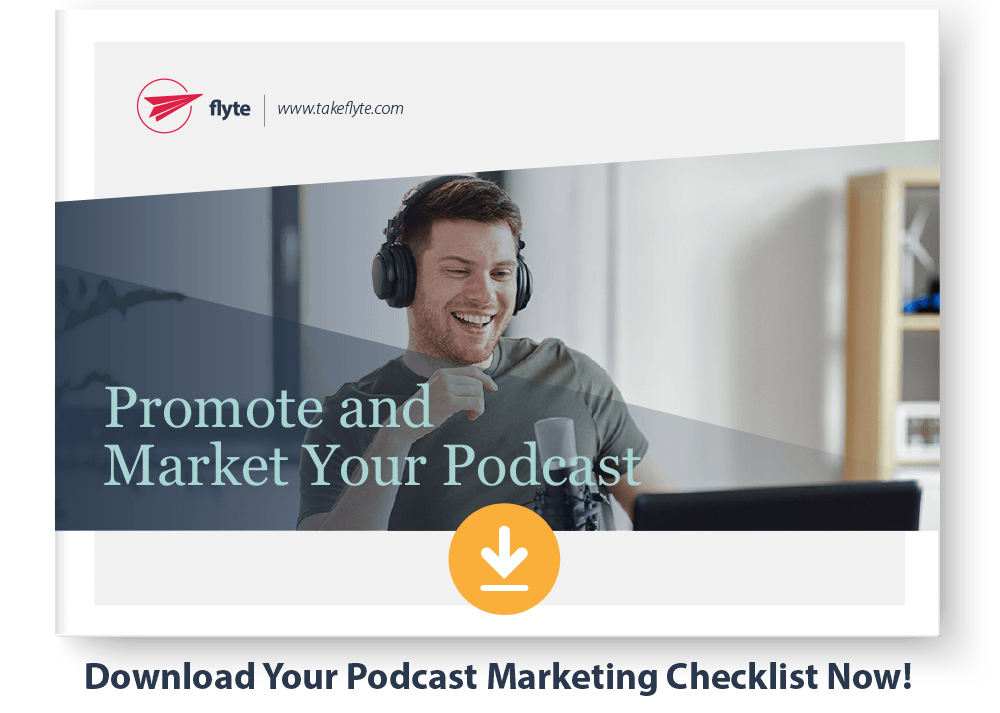 If you’re doing a podcast strictly for personal reasons…you just want to share your passion for The Umbrella Academy or your cat’s latest antics, then growing your audience may not be a priority.
If you’re doing a podcast strictly for personal reasons…you just want to share your passion for The Umbrella Academy or your cat’s latest antics, then growing your audience may not be a priority.
However, if you use a podcast to generate leads for your company, establish yourself as an expert in your field, or are trying to monetize your podcast in any way, then you’ll need a sizeable audience of people who share your passion.
While many people may listen to your podcast just to stay on top of the latest social media trends or leadership advice, others will ultimately look to hire someone to help them along their journey. By increasing your listenership, you increase the chances of reaching more of these potential clients.
In addition, a larger audience can bring other opportunities as well, including speaking gigs, guest spots on other podcasts, and book deals. You never know what connections your audience may have!
Some podcast marketing basics
Promote the podcast and each episode. Think back to the time before streaming TV. Networks would promote a show, say Friends or Magnum P.I., as well as each episode as it aired. Your strategy needs to do the same.
Narrow your focus. The narrower the topic, the easier it will be to market and promote your podcast. When a podcast is all over the place, jumping from topic to topic, it’s harder to convince people to take a chance on it.
A marketing podcast is ok. A digital marketing podcast is better. A podcast that focuses on chatbots is best, at least as when it comes to positioning and marketing your show. Now, you may attract a smaller audience by focusing entirely on chatbots, but it will be a passionate audience who will quickly see you as a thought leader in the space.
Hyper-focus each episode. Similarly, the more narrow the topic of each episode is, the easier it is to promote. When a guest tells me they can speak on Facebook Ads, email marketing, and web design, I usually suggest we stick to just one topic.
That way, when I’m sharing the episode on social media, I can promote the big reason someone should tune in: how to write subject lines that get people to open their emails, for instance.
Determine how the podcast fits in with the rest of your content marketing. Is it the centerpiece of your content marketing, and where you’re trying to drive all your traffic? Or is it just another outpost, and perhaps not as important to your business as your YouTube channel or Facebook group?
Understanding that will help you determine how much you should be promoting it. You can’t promote every platform equally, so understanding its importance will help you decide if you want to include a link to your latest episode in your email signature file or not.
Challenges to marketing your podcast
At flyte, we love our podcasts. We have our Agents of Change, our digital marketing podcast which has been going strong since 2012, and our Fast Forward Maine podcast, which started in 2018 and focuses on growing businesses in our home state.
But building an audience for podcasts doesn’t come without its challenges. According to recent statistics published by Edison Research, despite the fact that listenership has grown 37.5% between 2017 and 2020, only 55% of Americans have ever listened to a podcast, with only 37% listening in the last month.
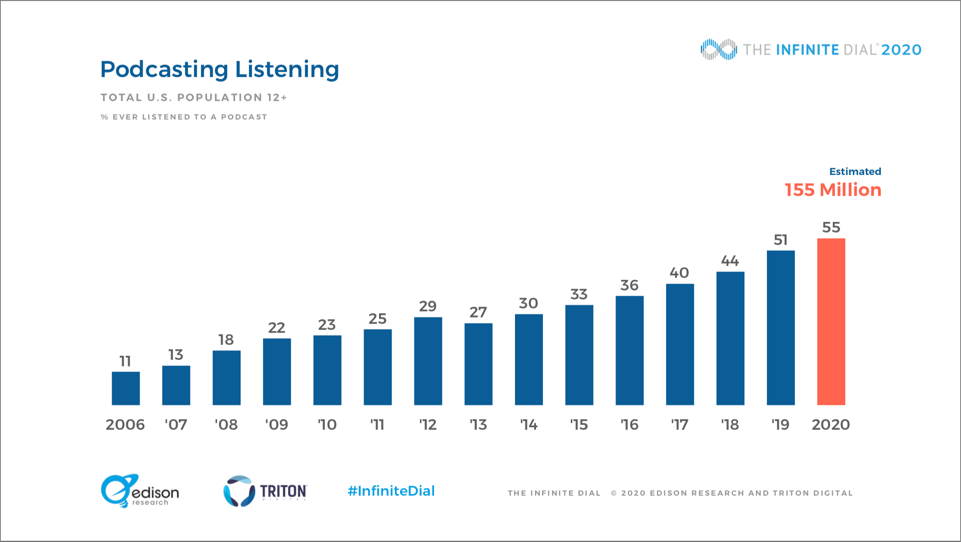
And of that 37%, most are likely listening to the most popular podcasts put on by media giants like ESPN, Fox, and NPR.
Does this mean you should give up? Of course not. You don’t need 37% of Americans (or any country, for that matter) to tune in for your podcast to be successful. Instead, focus on building your audience with passionate people in need of your services and expertise.
Branding and packaging your podcast
Ever pick up a bottle of wine, book, or album just because you liked the way it looked? Marketers, packaging experts, and branding professionals spend a lot of time so that their product jumps out at you from the shelves at your local market, bookstore, or record store. (They still have those, right?)
Well, when someone is perusing Apple Podcasts or Spotify for a new podcast, your podcast needs to leap out at them, too. This is a crowded marketplace, and the barrier to entry is low. If you don’t invest in the look and feel of your podcast, people will never notice it among all the other shows that have invested in their name, logo, and podcast artwork.
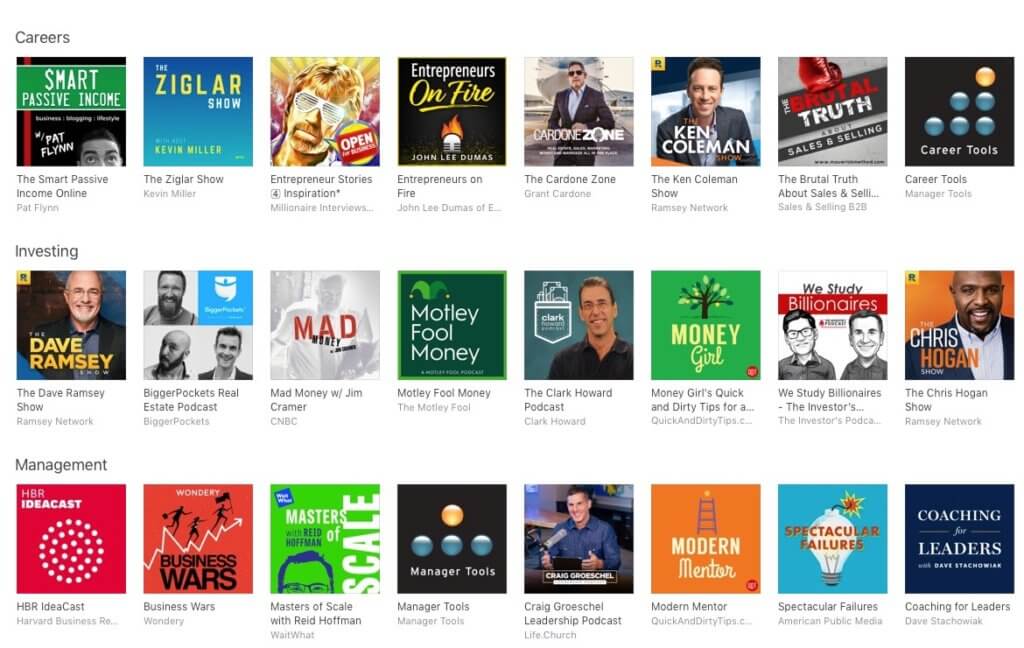
While the artwork will help your podcast pop, you should also consider the name of your podcast when it comes to search. If you’re Dave Ramsey or Malcolm Gladwell, you can probably get by on naming the podcast after yourself.
But if you’re not, you may want to work some keywords into your title or subtitle. “The Brutal Truth about Sales and Selling.” “Coaching for Leaders.” “Hardcore History.” And since “Agents of Change” isn’t what people interested in digital marketing podcasts are likely searching for, the official title in podcast directories is “The Agents of Change: SEO, Social Media, and Mobile Marketing for Small Business.”
You can further increase your chances of getting found at these podcasting directories by using your keywords in your description as well. Over the past few years some podcast directories–Apple Podcasts specifically–have been cracking down on over-optimizing your listings, so try not to go overboard.
Setting your podcast up for success

Once you’ve got your branding set, you should create design templates for the different social media platforms you’ll be using for promotion. This makes promoting each episode quick and easy.
You should also plan on launching with at least three episodes. This can increase your initial downloads, and can help push you into the New & Noteworthy section of Apple Podcasts (although that’s not quite the bump it used to be.) I recommend including an “episode zero” where you explain what the podcast is going to be about, and why people should subscribe.
Finally, I recommend using some sort of editorial calendar. Although a few popular podcasts publish whenever they want, the vast majority of shows publish regularly on a specific day and time. Having an editorial calendar can help you see if you’re running low on guests or topics before you realize you’ve run out of content.
Podcast website tips
If you want to grow your podcast audience, you’ll need a website. This can be a standalone website or part of your existing website. There’s no right or wrong answer here, but consider whether the podcast serves as part of your business’s existing content marketing, or whether it stands on its own.

There are many reasons why your show needs a website (or part of one):
- A place to host your podcast player, so people can listen with nothing more than their browser
- A place for show notes, links, and resources
- A place for value-add downloads to build your email list
- A place to send people who don’t know how to listen to or subscribe to a podcast
- A place to drive traffic to social media (as opposed to sending them to Apple Podcasts or Spotify which you don’t own or control)
- A place to optimize for the search engines
And once a visitor is at your episode’s show notes they can see all your other episodes, as well as your company’s offerings.
Create categories for your podcast website. Once you have a critical mass of shows, you should create hub pages that pull together episodes around a theme. A podcast on gardening might create a page on soil and composting.
Start with a keyword-rich page title, like Expert Advice on Soil and Composting for New Gardeners. Support that with relevant header and subheader tags, such as What is Loam? and Composting Tips for Beginners, and a great opening paragraph. The include a list of episodes that include titles, short descriptions, and links to each episode.
This will help new listeners find the content they’re looking for rather than scrolling through every episode.
Podcast SEO tips: optimizing your show for search
Your podcast can appear several times within Google’s search results. There’s the podcast section of your website, as well as the pages for individual episodes.
Google may also index your show on different podcast directories, such as Stitcher Radio, Apple Podcasts, Spotify, and more. It may index individual episodes within Google Play. If you have a Facebook or LinkedIn page for your podcast, those might appear as well.
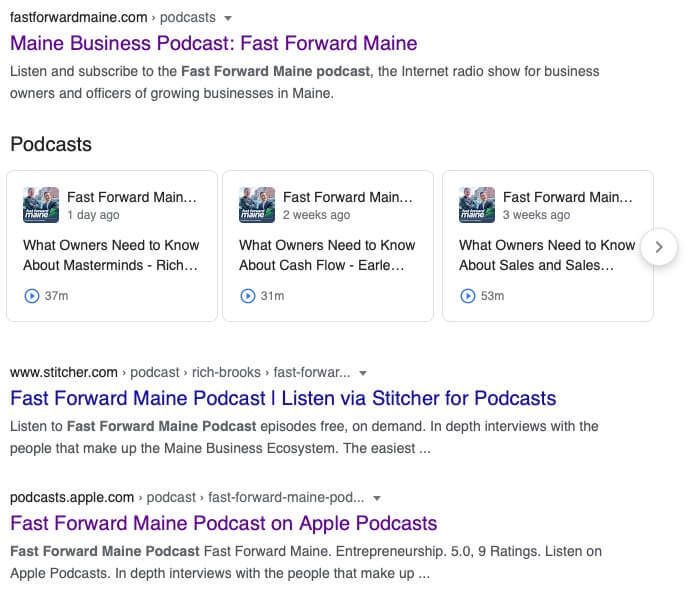
Optimizing your podcast to rank well in search is similar to optimizing any content to rank well in search. It’s about doing your keyword research, creating content that answers the questions your ideal customers are asking at Google, putting your keywords in the right places in the title, header, and description of your pages, and more.
However, it’s been my anecdotal experience that the average podcast episode with transcription doesn’t rank as well as the average blog. Why is that?
I don’t have science to back me up here, but I believe it’s because in a spoken interview, answers tend to be a little bit looser and more rambling. We might find ourselves or our guests going off on a tangent, or adding filler information, or not focusing on using the best keywords.
In a blog post, by comparison, you have the opportunity to review and revise your answer, honing it to the perfect response to a search query before posting it. This probably makes it easier for Google to understand, and therefore Google views it as a more relevant answer.
To get around this, you might decide to forgo a full transcript, and instead write up a blog post style recap based on the episode. However, that’s a significant additional amount of work, and you may decide it’s not worth it.
Inbound links are a key factor in search visibility, so to increase your chances of individual episodes ranking well, consider linking from previous episodes to the newly published ones. If possible, get your guests to link from their websites (not just their social media profiles) to the interview.
Marketing your podcast through social media
Every podcast can benefit from social media, but how prioritize what type of social media activity you should engage in?
Create your profiles. If your podcast is going to be the tentpole of your content marketing, then you should create a profile or page at the social media platforms where your audience hangs out.
That might include a Facebook page, a LinkedIn page, a YouTube channel, a Twitter profile, or an Instagram profile, depending on your topic and audience. Pinterest, Snapchat, and TikTok are also possibilities. These are great outposts to promote your episodes, your guests, ask questions from your audience, and otherwise engage your community.

Just remember not to spread yourself too thin! It’s fine to set up a profile at a platform to save your name, but you should focus your energies on where your community is most likely to engage.Promote each episode. At flyte, we have a promotional checklist that we run through for each episode for maximum reach. Besides linking to the episode, I will also write up a little blurb, explaining who the episode is for and what you’ll gain by listening to it.
I also make sure that I’ve tagged my guest and their company as I want to promote them, too. Plus, those tags can increase your post’s reach.
You don’t have to stop at just sharing a link to the episode. (After all, most social media platforms don’t want you siphoning off their traffic!) Waave is a tool that allows you to create engaging animated videos that play well on social media.
Post more than just your latest episode. A feed that’s nothing but one episode after another isn’t likely to get the engagement you’re looking for. Varying up your content, sharing memes and gifs, links to relevant content and other helpful sites is more likely to attract an audience that will like, follow, and connect with you.
Leveraging your guest’s network
Michael Stelzner of the Social Media Examiner and the Social Media Marketing Podcast once shared with me that he felt it was in bad form to ask your guest to market on your behalf. After all, they were doing you a favor by coming on the show. That advice definitely influenced my own thinking on the subject.
However, many hosts have no problem asking guests to market their interviews on social media, leave positive reviews on Apple Podcasts, and even send an email to their list. I once filled out a guest intake sheet that required me to promise that I would promote it a set number of times on a few different social media platforms! (I politely declined.)
I have no problem promoting an interview I’ve done on another podcast, but I do take exception by some of the aggressive tactics and follow up I’ve seen from certain podcasts. It’s left a bad taste in my mouth, and I don’t recommend those podcasts.
For my own podcasts, I take a middle ground. I don’t directly ask people to promote the episode, but for Agents of Change–where my guests are usually marketing experts who inherently know the benefits of promoting their appearances, I do send them an email that includes:
- A thank you for appearing
- A link to the show
- The graphics (featuring them) that we created (I want to show them how we’re promoting it)
- The code in case they’d like to embed it in a blog post at their own site
- Another thank you
For Fast Forward Maine, where we’re often interviewing guests that are less experienced with podcasting, I do a lot of the same, but I also talk to them about how they can leverage this content for their own benefit. In this framework I suggest:
- Promoting it in their and their company’s social media platform
- Adding it to the Media page on their website
- Including a link to the show in their next email newsletter
Again, with AOC guests, they are probably doing a lot of similar interviews; they don’t need to promote each one heavily. But with FFME guests, this is likely their only podcast appearance of the year. Promoting this heavily increases their own visibility and credibility.
Lastly, remember to tag your guests and their companies in your social media posts, as they’ll be more likely to like, comment, and share your post. Depending on the platform, their network may also see your promotional post.
Being a guest on other podcasts
One of the shortcomings of promoting an episode on say, Facebook, is that when someone is scrolling through Facebook, they may not be looking to pause for 20 – 40 minutes to listen to a podcast.
Most people who see your post probably aren’t regular podcast listeners. So, consider seeking out opportunities to appear on other people’s podcasts.
When you appear on other podcasts, you’re introduced to a new audience, but one that is obviously familiar with podcasting. They probably have their favorite podcasting app within reach, and if they like what you have to say, subscribing to your podcast is just a click or two away.
There’s an added SEO bonus as well, as most podcasts have that affiliated website, and they’ll be happy to link to you, your website, and your podcast. Those inbound links add up!
Finding podcasts to appear on takes a little virtual legwork. (Never skip a virtual leg day!) You can find relevant podcasts by searching through your favorite podcast directory on some of your keywords or in important categories.
For example, for the Agents of Change, I could search Apple Podcasts for “SEO,” “social media,” “small business,” and so on. I could also look through the Business category, and related subcategories.
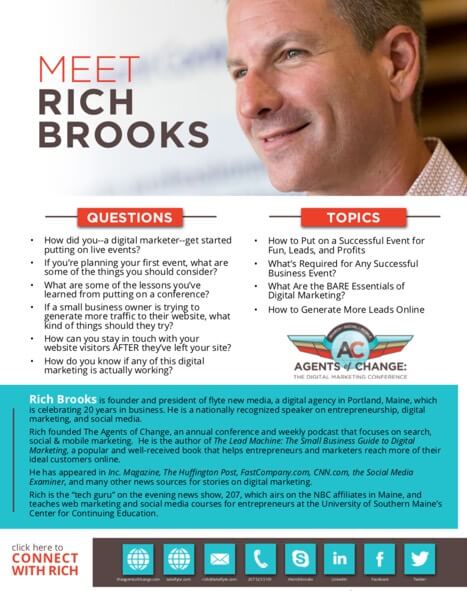 From there I would narrow it down to shows that use the interview format.
From there I would narrow it down to shows that use the interview format.
When I got my list of possible shows, I’d gather up other contact information including host names and emails, and put it in a spreadsheet, and begin outreach.
I might approach them through their website, connect with them on LinkedIn, or send them an email. Possibly all three!
It’s generally good practice to listen to an episode or two to get a sense of the show, so you can customize your email to them. Just do me a favor: don’t write an email that sounds like:
I love your podcast, especially [URL of randomly chosen episode]. I feel like I could come on and speak on [completely unrelated subject.]
This is also work that can be outsourced to an assistant who can speak on your behalf (or as you, depending on your comfort level.) There are also podcast booking companies (of course there are) who will do this legwork for you, and guarantee you bookings on appropriate shows.
As part of their services, they’ll also create a slick “one-pager” on you with your headshot, bio, topics, and potential questions to provide hosts. Prices for this often come out to about $200/episode.
Marketing your podcast via email
If you follow this blog or subscribe to my AOC podcast, you know that I feel just about every business can benefit from building an email list.
Your email list gives you an opportunity of reminding people about your podcast on a regular basis while promoting the individual topic and guest that episode.
Some subscribers may tire from weekly emails about your podcast, especially if they’re already subscribed to the podcast itself. Consider sending out non-podcast related content as well, or batching several episodes into a less-frequent email.
Find other email lists as well. For our Fast Forward Maine podcast, we realized we were one of the only providers of auditory business content in Maine. We found a number of business organizations in the state that sent out regular emails. With their permission, we send them information and links to each episode; if it’s relevant to their audience, they include it in their email, helping us reach a new audience.
Advertising your podcast
If you’re looking to juice your numbers, you should consider advertising your podcast.
Google Ads is a great platform for getting in front of people who aren’t familiar with your brand, but are looking for audio content that you can supply.
Facebook Ads can also work; you can target people based on their interests or what podcasts they already “like.” You can also use retargeting to promote new episodes to one-time listeners.
In fact, you can promote your show on just about any social media platform, but keep in mind that often people aren’t looking to leave Instagram or Twitter to listen to your podcast.
There are also platforms like Knit that will dynamically include ads for your podcast on other popular podcasts. Like search and social ads, you have some control over where and when these ads will run, too.
AudioGo offers dynamic ad placement on platforms such as iHeartRadio and Pandora. While these ads could be for anything, advertising on an audio-only platform appears to be a good way to get the word out to potential listeners.
Spotify has its own advertising platform, and some podcasting players like Overcast do as well. (Overcast is my podcast player of choice, but it’s only available for Apple products at this time.)
Promoting your podcast…in your podcast
You may wonder why you need to promote your podcast in your podcast…after all, aren’t people already listening?
Well, some listeners may not be subscribers. Getting random listeners to subscribe should be your goal, so promote the idea of subscribing in each episode.
Positive reviews can also help with visibility in certain podcasting directories, and can definitely increase the chances people will subscribe or at least listen to an episode. Don’t forget to ask people to leave a review at their favorite podcasting directory on a regular basis.
In fact, verbal calls to action at the beginning or end of the show can be a good idea for all aspects of your business. If you’re looking to move people to your email list, promote a free download related to an episode or to the podcast topic in general, available at your website behind an email registration.
Final Thoughts on Marketing Your Podcast
If all of this seems daunting, or even overwhelming, don’t worry. While I was doing all of these tasks when I first started out, my team now does almost everything, allowing me to focus on finding and interviewing guests.
If you don’t have a team, you can always hire one. If that’s not in your budget right now, get started by downloading our Podcast Promotion Checklist, based on what we do for our own shows. That should help simplify your workflow and keep you on task.
Enter your details to download our Podcast Marketing Checklist
And if you’re looking for an experienced guest for your podcast, consider me! I’ll probably even promote it…just don’t make that a requirement. 😉
